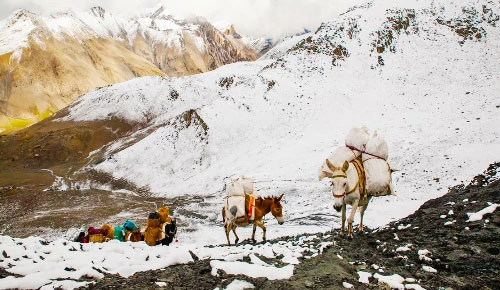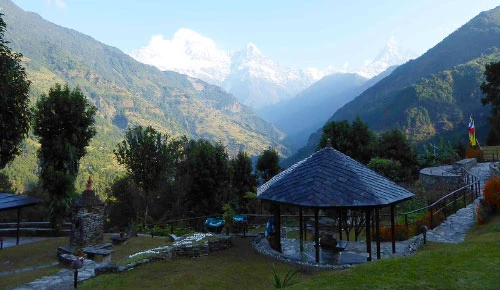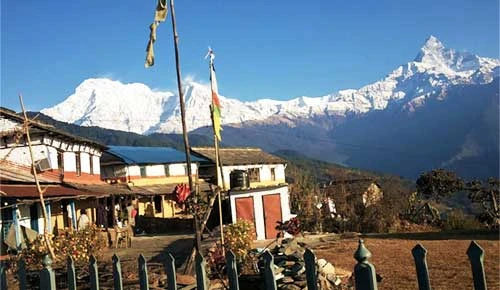Annapurna base camp Travel Guide
Annapurna Base Camp is a high mountain basin located in the central region of Nepal. It is surrounded by a ring of majestic peaks, including the Annapurna massif, and is considered one of the most popular trekking destinations in the world. The base camp is situated at an altitude of 4,130 meters and offers stunning views of the Himalayas.
The history of Annapurna Base Camp dates back to the 1950s when the first trek to the area was led by Maurice Herzog, a French mountaineer. Herzog, along with a team of climbers, reached the base camp in 1950 and became the first people to reach the summit of Annapurna I, the highest peak in the massif. This achievement was considered one of the greatest mountaineering feats of the 20th century.
Over the years, Annapurna Base Camp has become a popular destination for trekkers and adventurers from around the world. The trek offers a unique combination of scenic beauty, cultural diversity, and adventure, making it a sought-after destination for many. The trek route passes through beautiful forests, terraced farmlands, and traditional villages, offering trekkers a glimpse into the local way of life.
Annapurna Base Camp is a unique and historic destination that offers trekkers a once-in-a-lifetime experience. With its stunning natural beauty, cultural richness, and adventure opportunities, it continues to be one of the most popular trekking destinations in the world
Best time to visit Annapurna Base Camp
The best time to visit Annapurna Base Camp is during the months of September to November and March to May. During these months, the weather is clear, and the views are stunning, with the snow-capped peaks shining in the sunlight. The monsoon season from June to August can bring heavy rains, making the trek difficult and the trails slippery. December to February is the winter season, and the weather can be harsh, with temperatures dropping to sub-zero levels and snow covering the trails. Hence, the best time to visit Annapurna Base Camp is in the spring and autumn months when the weather is pleasant, and the trek is enjoyable.
Geography and Climate of Annapurna base camp
Annapurna Base Camp (ABC) is located in the central region of Nepal, at an altitude of approximately 4,130 meters (13,550 feet) above sea level. It lies within the Annapurna mountain range, which is part of the larger Himalayas mountain system. The ABC is situated in the north of the Pokhara valley, surrounded by the peaks of Annapurna South, Hiunchuli, Gangapurna, and Machhapuchhre.
The climate of Annapurna Base Camp is characterized by its high altitude and subalpine location. During the months of October to November, the temperature is mild and pleasant, with daytime temperatures ranging from 10°C to 15°C (50°F to 59°F). However, nighttime temperatures can drop to below freezing, so warm clothing is essential. During the monsoon season, which lasts from June to September, the region receives heavy rainfall, and the trail to the ABC can become difficult to navigate. The winter months of December to February can be very cold, with snow and icy conditions.
In general, the climate at Annapurna Base Camp can be unpredictable, with sudden changes in weather and temperature, so it's essential to be prepared for all eventualities. Despite the challenges posed by the weather, the stunning views of the Himalayas and the natural beauty of the region make the Annapurna Base Camp a popular destination for trekkers and mountaineers.
Accommodation in Annapurna base camp
Annapurna base camp trail is one of the most popular trekking routes in Nepal. There are various options available for accommodation along the trail, ranging from lodges, teahouses, and camping facilities.
- Lodges: There are numerous lodges and guesthouses along the Annapurna base camp trail. These are simple, yet comfortable, and provide basic amenities like beds, toilets, showers, and sometimes even hot water. Most lodges also have a common area where trekkers can relax, read books, and socialize. The lodges are also a good place to try local food and drinks.
- Teahouses: Teahouses are similar to lodges, but they offer more basic facilities. Teahouses are a great option for budget travelers as they are relatively cheap. They offer dormitory-style rooms and basic amenities like beds, toilets, and hot water.
- Camping: For those who prefer to camp, there are camping facilities available along the trail. The camping facilities include tents, sleeping bags, and mats, which can be rented at the starting point of the trek. Some trekking companies also offer guided camping treks, where they provide all the camping gear, food, and support staff.
Annapurna base camp trail offers a range of accommodation options to suit different budgets and preferences. From lodges and teahouses to camping facilities, there is something for everyone. Whether you prefer a comfortable bed or a rugged camping experience, the trail has it all.
Trekking Essentials in Annapurna base camp
Some of the basic essentials gear and things required if you are trekking to Annapurna base camp are listed below:
Clothing:
- Lightweight and quick-drying pants and shirts
- Fleece or down jacket
- Rain jacket or poncho
- Warm hat, gloves, and socks
- Hiking boots with good support and grip
- Sunglasses and sunscreen
Gear:
- Daypack for carrying essentials
- Sleeping bag and pad
- Headlamp with extra batteries
- Trekking poles for stability on rough terrain
- Trash bags for waste management
Food and water:
- Energy bars and snacks
- Rehydration powder or electrolyte tablets
- Water purification tablets or a filter system
- Hot beverages such as tea or coffee for early mornings
First Aid Supplies:
- Personal first aid kit with bandages, pain relievers, and antiseptic wipes
- Altitude sickness medication such as Diamox
- Water-resistant blister kit
- Insect repellent
- Cash for emergencies and tipping porters
Note: It is always best to check with local authorities and experienced trekkers for any additional essentials specific to your trip.
Cultural and environmental considerations
Trekking in the Annapurna region can be an enriching and life-changing experience, but it is important to approach this adventure with a sense of responsibility and respect for the local people and their culture, as well as the environment. Here are some guidelines to help you ensure that your trek is respectful and responsible.
- Cultural Awareness: The Annapurna region is home to several ethnic groups, each with its own unique customs, traditions, and beliefs. Be mindful of local customs, dress appropriately, and avoid behavior that may be considered rude or disrespectful.
- Festival Celebrations: If you are visiting the region during a local festival, it is important to be respectful and mindful of the events taking place. Avoid disrupting the celebrations and show appreciation for the cultural traditions being showcased.
- Respect Local Religion: The Annapurna region is predominantly Hindu, and there are many sacred temples and shrines in the area. Avoid taking photographs of these sites without permission and respect the religious beliefs of the local people.
- Support Local Businesses: Whenever possible, purchase goods and services from local shops, restaurants and vendors to support the local economy. Try to avoid buying goods from street vendors who may be selling items that were illegally obtained or who are taking advantage of tourists.
- Conservation Efforts: The Annapurna region is home to a diverse range of flora and fauna, and it is important to do your part to protect the environment. Avoid littering, minimize your waste and follow the "leave no trace" principle.
- Minimize Your Footprint: It is important to minimize your impact on the environment when trekking in the Annapurna region. Be mindful of your water usage, avoid cutting down trees and minimize the use of campfires.
- Respect Wildlife: The Annapurna region is home to a variety of wildlife, including endangered species. Avoid harassing animals and birds, and follow the guidelines set by your trekking company or guide to ensure that your behavior is responsible and respectful.
Trekking in the Annapurna region can be an incredible experience, but it is important to approach this adventure with a sense of responsibility and respect for the local culture and environment. By following these guidelines, you can help to preserve the beauty and wonder of the region for generations to come.
Activities and Attractions of Annapurna base camp
Annapurna Base Camp is a popular trekking destination in Nepal that offers a range of activities and attractions for visitors. Here are some of the most popular things to do and see in the Annapurna Base Camp area:
- Trekking: The main attraction of Annapurna Base Camp is the trek itself, which offers stunning views of the Annapurna massif, including the peaks of Annapurna South, Hiunchuli, Gangapurna, and Machhapuchhre (Fishtail).
- Scenic views: The trek takes you through diverse landscapes and scenic regions, including forests, bamboo groves, terraced fields, and traditional villages.
- Wildlife spotting: The Annapurna region is home to a variety of wildlife, including the Himalayan tahr, Himalayan black bear, and several species of birds.
- Cultural encounters: The Annapurna Base Camp trek takes you through traditional Gurung villages, where you can learn about the local culture and interact with the friendly locals.
- Visit Hot Springs: The hot springs of Jhinu Danda are a popular attraction for trekkers, as they are believed to have therapeutic properties.
- Meditation and yoga: Annapurna Base Camp is an ideal location for meditation and yoga, with its serene surroundings and beautiful natural setting.
- Explore local markets: The Annapurna region is known for its traditional markets, where you can find handmade crafts and locally grown produce.
These are just a few of the many activities and attractions that Annapurna Base Camp has to offer. Whether you're a seasoned trekker or a first-time visitor, this region offers something for everyone.
Safety and health considerations
Altitude sickness:
Altitude sickness is a common occurrence in high-altitude areas such as the Annapurna base camp. Symptoms include headache, nausea, fatigue, and shortness of breath. It is important to acclimatize gradually to avoid altitude sickness. This can be done by ascending slowly and taking breaks to rest along the way. It is also important to stay well hydrated. If symptoms persist, it is recommended to descend to a lower altitude.
Food and water safety:
It is important to be cautious about the food and water consumed in the Annapurna base camp. It is recommended to only drink boiled or treated water, and to avoid raw fruits and vegetables that may have been contaminated. Food should be thoroughly cooked to ensure that it is safe to eat.
Emergency evacuation procedures:
In case of an emergency, it is important to have a plan for evacuation. This includes having a basic first aid kit and a communication device, such as a satellite phone, to contact help. It is also important to familiarize oneself with the area and know the evacuation route in case of an emergency. Guides and porters should be trained in emergency procedures and should be aware of the location of the nearest hospital or medical facilities. In case of an emergency, it is important to remain calm and follow the evacuation procedures as outlined by the local authorities.
Trekking and tour packages to Annapurna base camp
Annapurna Base Camp Trek: This is a popular trekking package that takes you to Annapurna Base Camp at an altitude of 4,130 meters. It is a 12-day trek that takes you through stunning landscapes, traditional villages, and diverse flora and fauna.
Annapurna Base Camp Luxury Trek: This is a premium trekking package that takes you to the Annapurna Base Camp with the comfort of luxury lodges and hotels. The trek lasts for 10 days and offers breathtaking views of the mountains, terraced fields, and scenic forests.
Annapurna sanctuary Trekking: The trekking to Annapurna Sanctuary in Nepal is among the most well-known in the world due to the sweeping mountain views. The Annapurna Himalayas' wide and magnificent Annapurna glacier is where the challenges merge with the moraines and reach the realm of snow during the stunning dawn and sunset.
Annapurna Base Camp Helicopter Tour: This is the ultimate tour package that takes you to the Annapurna Base Camp by helicopter and lets you explore the mountains from above.
Annapurna Circuit Trek: Annapurna Circuit trek is a popular trekking route that encircles the Annapurna mountain range in Nepal. The trek takes roughly 12-21 days to complete and reaches a maximum altitude of 5,416 meters (17,769 feet) at Thorong La Pass. The trek offers a unique combination of natural beauty, cultural experiences, and challenging hikes, making it a must-do for adventurous travelers and trekkers.



